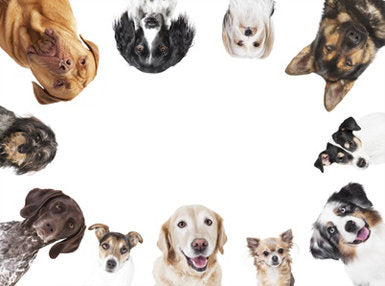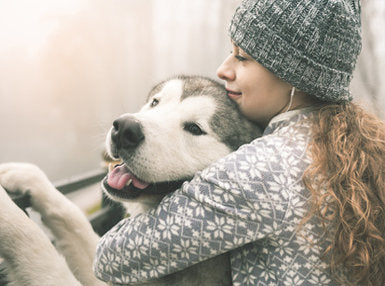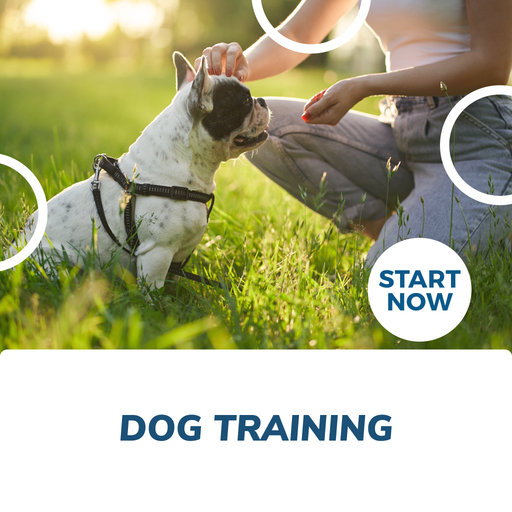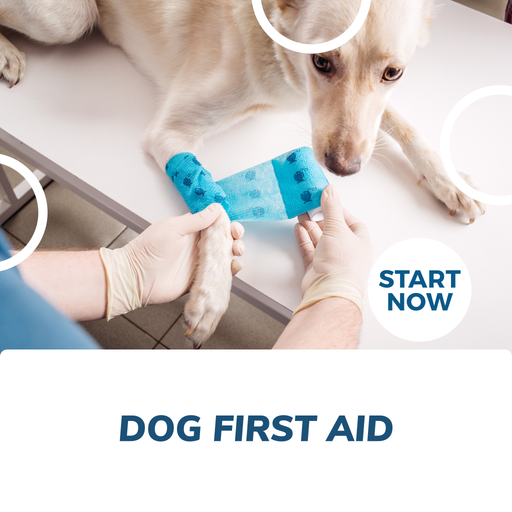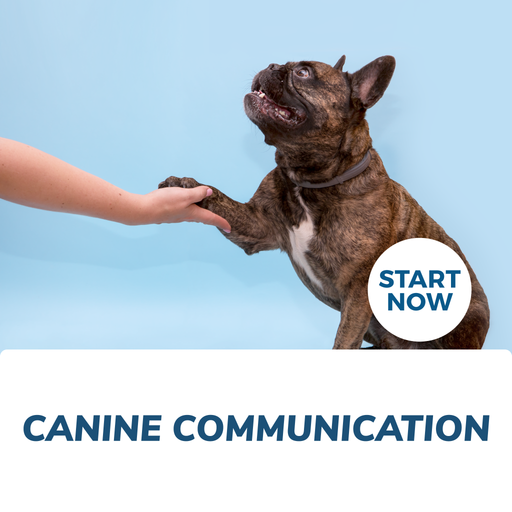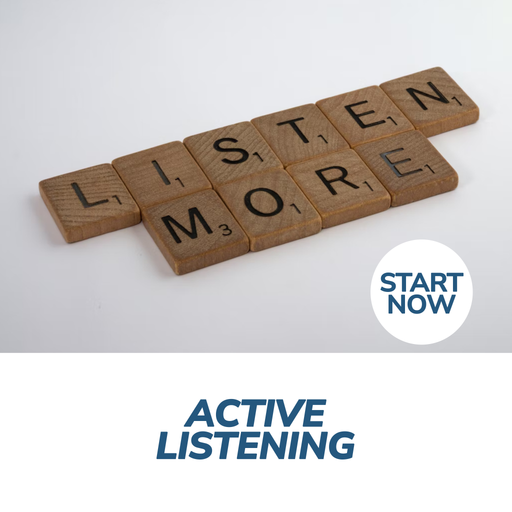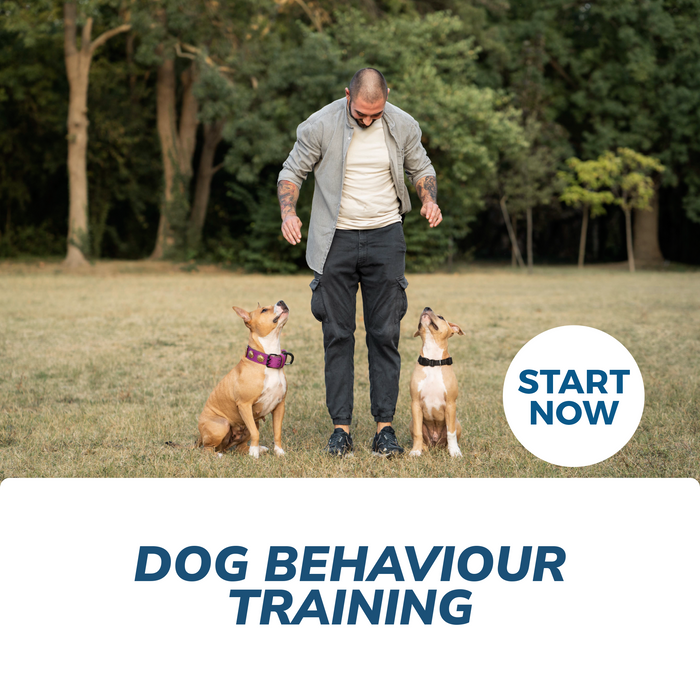
About This Course
What you will learn
|
|
Study Dog Behavior Online Course and Get a Better Understanding of Dogs
Our Dog Behavior Online Course provide a comprehensive introduction to today's dogs. This includes how dogs developed and became a part of human life to how their brains function. By taking this course, you will discover the latest in dog communication and how to live a more productive life with your dogs.
Dogs are popular with people. Do humans, on the other hand, comprehend dogs? Is it possible to determine what your dog is feeling? Do you know how to calm a stressed dog or the length of time it takes for adrenaline to leave a dog's body? What us the reason why dogs attack and how their Behavior is vastly different.
You'll have a better grasp of how to train your dog and the different Behavior modification techniques, including how they became popular and their effects on dogs. You will also learn how to recognize the dog's important body language and different signals, as well as how your actions and Behaviors frequently mislead your canine communication efforts.
Who would benefit from this course?
This course is ideal for all dog lovers.
Written by a canine Behavior specialist with over 15 years experience in the field and backed up by scientific knowledge, the course can help to change your life and your relationship with any dog that you come into contact with.
This course is ideal for those that have a dog or those that work with dogs in any capacity and want to understand and improve their relationships with their furry companion.
Why Choose CFS’ Dog Behavior Course
Are you a dog enthusiast, groomer, or professional looking to enhance your skill set and take your dog-related career to the next level? If so, signing up for a dog behavior course with CFS is an excellent way to do just that.
Our dog behavior course covers topics such as canine emotion and cognition, advanced handling and training techniques, health and fitness tips for dogs, body language interpretation, breeding and genetics, business management skills for professional dog trainers, and more.
Individual courses are ideal for anyone wanting to get into canine behavior consulting or simply to learn more about canine behaviors in general. Behavior consultant certification is just one way the professional certificate you'll receive on completion of CFS courses will benefit.
You’ll have the opportunity to learn:
- presenting information clearly in hierarchy-based structures
- showing compassion for behavior issues without using any form of punishment
- establishing trust through gentle interaction
- recognizing early signs of tension or stress
- developing communication skills between animals and owners via verbal cues (such as names) and body language
- minimizing distractions during training sessions
- applying minimally aversive problem-solving approaches when addressing challenging behaviors
- providing plenty of praise during successful interactions
- understanding how older dogs learn differently than puppies
- focusing on reward-based methodology rather than fear-based motivations
- offering advice around nutrition and fitness for all ages of dogs
- teaching puppy development classes which emphasize positive reinforcement techniques instead of relying solely on obedience training commands initially
All these components make up the skill set necessary to become an effective dog trainer—the ultimate goal when taking this dog behavior course.
So, if you’re serious about making a career out of helping pet owners better understand their furry companions while improving their well-being through humane training methods — this course in canine behavior is an important first step.
Course Fast Facts:
● Learn the fundamentals of Canine Training
● Written and developed by leading canine experts
● Unlimited, lifetime access to online course
● Certificate of completion awarded with passing score for the online assessment
● Study at your own pace with no rigid class timetables, 24/7 from any computer or smart device
Course Delivery
Courses are accessed online by any device including PC, tablet or Smart Phone. Upon purchase an automated welcome email will be sent to you (please check your junk email inbox if not received as this is an automated email), in order for you to access your online course, which is Available 24/7 on any computer or smart mobile device.
Dog Behavior Online Course Outline
Module 1: Introduction
This introductory subject will cover the notion of dog behavioral training and its function in coexisting with animals. It may be both exhilarating and daunting to welcome a new puppy into the family. Dog owners are responsible for learning about their pet's distinctive personality and demands and caring for a devoted new buddy. However, there are a variety of scenarios in which hiring a professional dog trainer is an excellent option.
Defining Dog Behavioral Training
The distinction between behavioral training and obedience training for dogs is often misunderstood. Many people mistakenly believe they are the same, yet there are many differences. Only introduce instructions, define limits, and educate dogs to respond promptly to signals during obedience training. It is an excellent choice for puppies and dogs of all ages.
Canine Evolution
The wolf has been associated with a man for tens of thousands of years, when wolves accompany humans, scavenging and feeding on the scraps left behind. It did not take long for humans to notice the dog's innate ability to hunt and locate down prey. Domesticated pets have the same prey drive as wild animals. It is obvious when people play catch with golden retrievers or when farmers use border collies to herd lambs. It is considered part of a dog's natural prey drive if they suddenly bolt after a squirrel while on a stroll.
Module 2: Canine Senses
Dogs have the same five senses as humans: sight, smell, hearing, taste, and touch. Specific investigations would add a sixth sense to the mix: energy-sensing. This session looks at how dogs perceive the environment and their senses. These distinctions can significantly influence how dogs are trained and how psychology is applied to them.
Sight
It is necessary to understand the eye's anatomy to comprehend better how dogs view the world. The sensitive component of the eye, the retina, is positioned inside the eye and perceives light. Rods and cones are the two types of light sensors. Colour vision is specialized by cones, which are light receptors present in the retina. Green, blue, and red cones are seen in humans. Blue and yellow receptors are the only ones found in dogs.
Touch
Dogs have limited senses at birth, with their eyes closed and their hearing still developing. As a result, touch is one of the most crucial senses they use in their early years. Dogs have to touch receptors throughout their bodies that feel pain, temperature, pressure, and movement. When they sense their moms' heat, they flee for safety. Mothers welcome their puppies by kissing them on the nose, which signals the presence of food.
Hearing
It takes 21 days for a puppy's hearing to completely mature. By the time their hearing is wholly grown, they can hear twice as many frequencies as humans. Human hearing varies from 20 to 20,000 Hz, but dogs' hearing spans 20 to 45,000 Hz. This enables them to detect high-pitched sounds, which explains why vacuum cleaners and food blenders upset them so much.
Taste
On their tongues, dogs have 1,700 taste buds compared to 9,000 taste buds in humans. Dogs have a fourth of the taste buds that humans have, yet they can detect all flavours: sweet, spicy, bitter, sour, and salty.
Smell
Dogs rely significantly on their sense of smell from the moment they are born. Humans only have about 6 million olfactory receptors, but dogs have roughly 300 million. It is fascinating to learn that the part of a dog's brain that recognizes scent has 40 times more neural connections than the human brain. The nostrils of dogs are also built differently.
Module 3: Social Structures
Canines have evolved to like to live in packs. To ensure maximum survival, a pack of canines lives together and supports one another. Dogs were domesticated because of their sociability and propensity to bond with people. However, their inherent group instinct did not go away; dogs still display pack locations and divisions indicators.
Hierarchy
A dog can serve in one of three roles in its pack—a pair consisting of the alpha female and male claims the alpha status. The beta position, on the other hand, is made up of dogs who serve the alphas. Finally, there are the omegas, who look after everyone else. Scientists discovered that the alpha pair leads the pack from the front, based on observations of wolf or wild dog packs. They steer the group in the right direction.
Social Habits and Age
Dogs learn to be separated into roles from when they are born until they are seven weeks old. This first manifests itself while they are feeding with their mother. The natural alpha puppies will be fed first and will receive the most milk, while the more subordinate canines will be fed later. During playing, puppies up to the age of eight weeks separate into positions. Puppies who are leaders will be bold and confident in their demeanour.
Module 4: Canine Communication
This section will look at how dogs interact with one another through facial expressions, gestures, head postures, and barking. We will also learn about the various methods that dogs interact with people, which have evolved. There are also five other sorts of canine communication that we may use to figure out what canines are attempting to say through their actions.
Facial Expressions
Dogs use facial expressions to communicate their sentiments to other dogs. Other dogs can tell that they are comfortable if they have a gentle gaze, an open mouth, and their ears forward. When it comes to communication, dogs do not rely on facial expressions as much as humans do.
Movements
Dogs may convey their intentions by making particular motions. A play bow can be used to request play or demonstrate that they are not threatening another dog.
Head Positions
The way a dog's head is positioned might reveal a lot about how they feel about another dog. They may be submitting or dejected if they keep their head down.
Barking
Dogs interact with one another primarily through barking. Dogs may emit hundreds of distinct barks, each with a varied pitch and loudness.
How Dogs Communicate with People
When it comes to people, dogs have an astounding assortment of communication signs. They use both verbal and nonverbal clues all the time. Whether we realize it or not, we are also speaking with them. Dogs may even change their communication style to suit their human companions.
Tail Language
Dogs communicate through a variety of visual cues, one of which is the use of their tails. Your dog's curled tail may indicate that he or she is at ease. It can also imply that it is self-assured or domineering. A stiff and straight tail may indicate that the dog is following or tracking something. Fearful or submissive dogs have their tails tucked.
Ear Language
A dog's ears may reveal a lot about its temperament. If the dog's ears are perky, it is assumed that it is intrigued and interested in what will happen next.
Eye Language
Dogs' eyes may convey a wide range of emotions. The well-known "sad puppy eyes" suggest that the dog is desirous of attention. When dogs receive delightful treatment, such as belly rubs or scratching behind their ears, they prefer to close their eyes.
Mouth Language
● When dogs are smiling with happiness, you can visibly tell by looking at their entire body. Their ears will be floppy or relaxed with soft eyes.
● If the dog is showing its bare teeth, it might communicate signs of unhappiness, fear, or even aggression.
The Five Types of Canine Communication
A dog may communicate in five different ways, either alone or in a group.
Fearful Communication
When a dog feels afraid, he may exhibit various behaviors such as licking his lips or yawning. It may make submissive motions such as lowering its body. In the face of active fear-inducing stimuli, the dog may shiver or turn away from it completely, avoiding eye contact.
Arousal Communication
Arousal communication can be triggered by various cues that differ depending on a dog's age, especially if it is in its teenage period. In the presence of a human, a toy, or another dog, they may become stimulated.
Anxious Communication
Excessive panting, pacing, and a general lack of attention are all signs of a nervous dog. A worried dog may lick its lips or avoid eye contact, similar to terrified communication. The dog may even exhibit aroused communication-like behavior. Anxiety may lead to various undesirable behaviors, such as trashing household belongings or urinating improperly inside.
Aggressive Communication
Stimuli that might be seen as a danger, such as a dog, person, or item, can cause dogs to get triggered. When confronted with a threat, the dog could tense up, snarl, or expose bare fangs.
Relaxed Communication
When dogs are calm, they will wag their tails. A relaxed gaze and a loose body posture indicate that a dog is comfortable and confident. When a dog is relaxed, he will frequently seek attention or engage in playful behavior.
Module 5: Learning and Conditioning
This section will look at the training process for dogs and what motivates them to act in specific ways. We will go through many tactics and methods for encouraging positive behavior and breaking undesirable habits. To get dogs to perform what you want, you may utilize a variety of conditioning techniques. Dogs can be taught to substitute a negative behavior with a good one via training.
How Dogs Learn
The majority of dog behavior is rational. We can notice that dogs are opportunists if we pay attention to them while they are being trained. They learn new skills so that they may show them to their owners and elicit the appropriate response.
Conditioning
Dogs may learn new skills and habits in a variety of ways. During the learning process, social learning is a notion that is frequently noticed. This means that a dog will learn to imitate the behavior of other dogs with whom it spends much time. Conditioning is the idea that it becomes more common when some positive reward immediately follows an action or a response. We do this with dogs regularly, whether we realize it or not.
Classical Conditioning
According to this notion, any type of learning is essentially accomplished by association. When any two stimuli are connected, it results in a learnt reaction.
Advantages and Disadvantages of Classical Conditioning
Classical conditioning has numerous advantages, but it also has certain drawbacks and flaws. It might be beneficial to examine how classical conditioning has been implemented in humans when initially learning about these topics. Consider how these results may be adapted to dogs and the behavioral concerns that arise over time.
Pavlov's Experiment
When he was examining the digesting process of dogs, Ivan Pavlov, a Russian scientist, developed the idea of classical conditioning. He noticed differences in his dogs' responses to food over time. He discovered that dogs would salivate when food was placed right in front of them at first, but that with time, they began salivating even before the meal came. When they watched the meal being brought in on a cart, he observed they began salivating.
Operant Conditioning
The consequence is a phrase that must be remembered while discussing operant conditioning. According to operant conditioning, a subject will learn the consequences of a specific action. It could be both positive and negative. This influences whether or not we decide to repeat the activity. Owners of dogs frequently use operant conditioning on them without even recognizing it.
Module 6: Sources of Canine Stress
Stress is a mental and emotional state brought on by a sense of being threatened or challenged. Humans are capable of recognizing and determining the source of their stress. They next seek to eradicate the source of the problem, which gradually relieves the stress. Canine stress is equally prevalent, although it is handled differently by dogs. Stressed dogs are less prone to express themselves openly. It might show itself as a change in body language or a change in conduct.
Signs of Stress
Dogs primarily convey their requirements through body language. The symptoms of dog stress are subtle and might be mistaken for expected behavior. Humans must pay close attention to these symptoms to identify the cause and help avoid the stressful circumstance from recurring. If the stressor is unavoidable, such as leaving the house, it may be essential to work with the dog to lessen the stress reaction.
Responding to Stress
Every dog reacts to stress uniquely. Dogs' behavior can vary dramatically after being subjected to stress. A dog's refusal to eat might be a result of stress. A dog's appetite might be affected by sudden stress. During a stressful event, hormones like adrenaline and noradrenaline are produced, impacting the dog's appetite.
Common Sources of Stress
In order to eliminate the variables that create canine stress in the first place, it is crucial to understand changes in dog behavior and determine the root causes.
● New surroundings: Dogs get used to familiar surroundings and feel comfortable in them. Moving to a new house or visiting a new place can be an overwhelming experience for them. Dogs quickly get stressed in a new environment and need time to adjust.
● Rearranging furniture: Many things that are insignificant for humans can be massive changes for dogs. For example, just rearranging the furniture in the living room can cause stress in a dog. The reason is that a new arrangement can restrict dogs from moving about in their usual pattern, which can agitate them.
Module 7: Behavioral Problems
A dog's innate response to anything is frequently seen as negative behavior. Without formal training, this may easily be remedied. Long-term behavioral issues or those stemming from strong emotions, on the other hand, might be difficult to refocus and rectify.
Categorizing Behavior
Understanding the origins of undesired habits might help you better regulate or prevent them.
● Normal behavior
● Challenging behavior
● Abnormal behavior
Common Behavioral Problems
● Chewing on things: Puppies can chew on things because of teething or just out of curiosity. On the other hand, boredom or anxiety can make adult dogs chew household things. Introducing a chew toy is a good solution.
● Digging outside: This is a basic instinct of dogs. Mostly, they dig to sit in cold soil during hot days. It becomes a problem if they are destroying your whole lawn. Letting the dog dig in a designated area can help in this situation.
● Unreasonable chasing: The predatory instinct of dogs makes them chase after moving objects such as people, other animals, and moving cars. Keep them on a leash when going outside or teach them to come back when called to avoid any accident.
How Age Affects Behavior
The behavior of a dog alters as it gets older. As they get older, they may become annoyed by a variety of things. Dogs can also acquire canine cognitive dysfunction (CCD) as they become older, harming their behavior and quality of life.
Module 8: Training Techniques
Dogs are sociable creatures, and their owners enjoy having them around for a variety of reasons. However, just because you love a dog does not mean you have to put up with all of its bad habits. When dog owners discover behavior problems, they may try to solve the problem on their own before seeking the help of a professional dog trainer. Trainers are more likely to know how to use various techniques and judge how a dog's behavior improves as a consequence.
Aversion Training
Aversion training is a type of behavior modification that trains a dog to avoid performing a particular activity. To avoid receiving negative feedback, such as a bitter taste, dogs must perform the correct thing. Aversion training entails correcting a dog using either negative reinforcement or positive punishment tactics.
Positive Reinforcement
Dawn Sylvia-Stasiewicz pioneered the positive reinforcement dog training approach. She was in charge of training the Obamas' dog, Bo. This method is based on the concept that dogs require a reward in order to repeat positive behavior. Treats or toys might be used as rewards. Consider the following scenario: you are the dog owner, and you notice your dog eliminating outside the home. When you recognize this positive conduct, you instantly reward it.
Science-Based Training
The scientific training approach aims to comprehend the nature of dogs and how to educate them using appropriate penalties and incentives. Dog trainers are continuously developing new trials and tactics to understand the nature and psychology of dogs better.
Mirror or Model–Rival Training
We spoke about observational learning in module 6. A dog must mimic the excellent conduct of a different model dog in the mirror or model–rival behavioral training approach. This can be accomplished by exposing the dog in training to the surroundings of the competing dog so that they can interact or compete. Instead of introducing a competing dog, some trainers will serve as the model or employ another person.
Clicker Training
Most dog trainers who use the positive reinforcement technique also use clicker training for more effective outcomes. Hence clicker training is a subset of positive reinforcement training. The use of a clicker to signal a dog's positive behavior is known as clicker training.
Electric Behavioral Training
When using an electric collar to train a dog, the emphasis is on punishment rather than incentives. Dog trainers that wish to confine their canines inside a physical border can use the electric collar. Hunting dogs and those who operate in herding conditions may benefit from the usage of electric collars. Although some dog trainers have praised the efficiency of the electric training approach, others say it is not the best method for teaching dogs.
Dominance Training
Other training approaches differ from the dominance or "alpha dog" behavior training style. In this scenario, you train a dog to be more obedient using a pack mindset. According to proponents of this approach, dogs have a pack and alpha mentality that must be tamed in order for them to learn to appreciate their trainers. To use this method to correct bad behavior in dogs properly, you must first grasp their nature, psychology, and body language and predict their reaction pattern.
Module 9: Managing Aggression
Aggressive behavior in dogs seldom occurs on its own. When a dog is confronted with a circumstance that makes them feel protective, they will usually exhibit a succession of behavioral or body-language signs that increase severity. These signals start mild, but if not addressed, they can lead to aggressive conduct.
Signalling
Dogs seldom display aggressive behavior on their own. When a dog is confronted with a circumstance in which they feel threatened, they will often exhibit a succession of behavioral or body-language signs that increase severity. If no action is taken, these signals will progress to hostile conduct.
Responding to Aggression
When dealing with dog aggressiveness, owners may be inclined to punish the animal. When it comes to dealing with hostility, this should be the very last resort. In reality, before responding to dog aggressiveness, owners should analyze the source of the hostility and solve that issue first. Aggression in dogs, for example, typically stems from a defensive position in response to something or someone they are afraid of, as stated above.
Potentially Aggressive Dogs
When working with a potentially hostile animal, it is essential first to get to know the dog. As a trainer, this entails conversing with the dog's owner and gaining a thorough understanding of the animal's behavior. Learn what signs the dog uses most often so you can stay on track as you progress through training. Determine if the dog's hostility is more protective or more dominating.
Evaluating Temperament Before Training
Evaluating a dog's baseline temperament is one way to assist create a more enjoyable training experience. This entails putting the dog in unexpected circumstances and observing its behavior closely. Exploring three significant circumstances is one approach for owners to measure temperament. First, put the dog in a position where a stranger comes up to you and ignores him. Then have a stranger approach you and adequately communicate with the dog. Finally, have a stranger make a frightening approach to you.
Module 10: Equipment and Environment
Many different sorts of materials are required to teach your dog or operate as a professional trainer effectively. This contains items that enhance positive behavioral connections and other auxiliary tools relating to the behavioral issue at hand.
Reward Items
Reward items are provided to your dog in order to encourage positive behavior. A clicker is one of the essential training tools. You will need goodies for training because clickers are usually combined with sweets. You can use kibble or natural treats, but anything tiny should be used.
Issue-Specific Items
You may also use a range of additional tools to train your dog. Dogs that misbehave on walks, for example, will require a leash to learn good walking behavior. The leash may also be used for other purposes in training since it gives you control over the dog.
Safety Equipment
Muzzles and other personal protection equipment are not the only types of safety equipment available.
● Fire extinguishers
● Pesticides to keep outdoor areas free of insects and pests
● Gates and barriers to block rooms without doors
Creating a Comfortable Training Environment
Dogs must be at ease and confident in training set in order to be effective. Learn everything there is to know about each dog, including its quirks.
Module 11: Safety
There are many dangers and threats in the world. In the blink of an eye, danger may find any human or canine. Accidental damage or sickness can happen to even the best-behaved or well-trained pets. There are, however, things that may be done to decrease the number of possible threats that a dog may encounter. Making tiny improvements to the dog's location might be as essential as studying canine first aid and CPR.
Environment
Some dog owners choose to teach their pets in their own homes. A list of fundamental improvements to make a dog safe in its environment, whether indoors or out, is provided below.
● Completely secure all chemicals and other hazards that can be dangerous to a dog if exposed or ingested.
● Keep all electrical cords out of reach.
● Unless a dog is being trained to return on command, always keep it on a leash.
Signs of Injuries or Illness
Dogs, like people, are all different and can display indications of injury or disease in several ways. Because dogs cannot communicate directly with us, it can be challenging to determine whether or not there is cause for concern.
● A vocal dog is becoming quiet or excessive yelling, crying, etc.
● Loss of appetite
● Increase or decrease in water intake or urination
● Social changes
● Aggression
Trainer Safety
While training, dogs can experience a wide range of emotions, putting the trainer's safety in jeopardy. A list of bare acts that can be critical to a dog trainer's safety is provided below.
● Always approach a new dog slowly and carefully. Let them come to you and smell you first.
● Be aware of all medical records and whether a dog has or has had any injuries or illnesses.
● Ensure that a dog's harness or collar is properly fitting so that they will not slip out of it.
Protective Equipment
When it comes to dog training scenarios, when protective equipment is required, it may make all the difference in the trainer's and the dog's safety. It is likely that, in some instances, the visibility of all the protective gear makes a dog feel even more intimidated, provoking an attack.
● Harness and collar to position the dog
● Muzzles
● Closed-toed shoes
Module 12: Classes and Resources
Dog training may be a challenging yet rewarding experience for both the dog and the owner. To attain the best outcomes, some dogs may require a bit of extra coaching. Of course, different resources for behavioural training are accessible in different regions. There are a variety of helpful organizations with resources to assist dog owners in finding the perfect trainer.
Internet Searches
For both the dog and the owner, dog training may be a challenging but rewarding process. To get the best outcomes, some dogs may require a bit more instruction. Behavioural training materials are, of course, varied in each place. Several valuable organizations may assist dog owners in finding the correct trainer.
Initial Discussion
Potential clients are likely to inquire about each trainer's background while selecting a trainer. Dog trainers should describe their skill sets and expertise working with a wide range of behavioural issues.
Types of Professional Programs
The desired objective determines the sort of training that is appropriate for a dog. Obedience lessons are available in a variety of levels to teach a dog fundamental cues and actions. These may be useful for very young dogs whose poor habits result from a lack of general training. Dogs will learn additional instructions and how to redirect their behaviour as they go through the stages of an obedience school.
Recommendations
A veterinarian or a dog boarding facility may be able to refer you to a specific trainer. Because many dog owners have behavioural challenges at some time, they are more likely to seek advice from someone they already have a relationship with.
Module 13: Specialty Behavioral Training
We will talk about behavioural training for particular sorts of working dogs in this module. Working dogs have been extensively taught to do specific tasks. However, this does not rule out the possibility of their having behavioural issues following their initial instruction.
Police Dogs
A K9, sometimes known as a police dog, is a canine that has been exceptionally trained to assist police and other law enforcement officers. Detecting drugs and explosives, identifying missing people, discovering crime scene evidence, and apprehending fleeing suspects are some of their tasks.
Search-and-Rescue Animals
SAR canines are trained to locate missing people in the aftermath of a disaster or other occurrence. Humans have been discovered by dogs underwater, snow, and collapsed constructions.
Therapy Dogs
A therapy dog is a dog that has been trained to provide people with affection, comfort, and support in some settings, such as hospitals, retirement homes, and schools. Therapy dogs are taught to interact with people other than their handlers, unlike assistance dogs, trained to aid specific patients with their day-to-day physical needs.
Recognition & Accreditation
Upon successful completion of this course and achieving a passing score for the assessment, you will be issued with an international continuing education credit (CEU) certificate.
This Certificate is applicable worldwide, which demonstrates your commitment to learning new skills. You can share the certificate with your friends, relatives, co-workers, and potential employers. Also, include it in your resume/CV, professional social media profiles and job applications
Further learning
When researching courses or programs in this field, look for those offering comprehensive coverage of multiple important topics so you can expand your education further if you wisht o do so. For example, advanced programs with CFS may include sections on individual courses such as computer networking and electrical engineering; others might focus more on continuing education classes such as English language proficiency or digital marketing.
Units of Study
Unit 1: Introduction
- Define dog behavioral training
- Canine evolution over time
- History of dogs living and working with human beings
Unit 2: Canine Senses
- Canine senses
- How sensory processing differs from humans
- Importance of smell
Unit 3: Social Structures
- The idea of a “pack”
- How dogs interact and socially develop by age
Unit 4: Canine Communication
- How dogs communicate with one another
- How dogs communicate with people
- The five types of communication
Unit 5: Learning and Conditioning
- How dogs learn new things
- Conditioning
Unit 6: Sources of Canine Stress
- Signs of stress in dogs
- How dogs respond to stress
- Common sources of stress
Unit 7: Behavioral Problems
- Common behavioral problems seen in dogs
- How age affects behavior
Unit 8: Training Techniques
- Aversion training
- Clickers
- Positive reinforcement
Unit 9: Managing Aggression
- Signs of aggression in dogs
- Responding to aggression
- Conducting training with an aggressive animal
- Evaluating temperament before training
Unit 10: Equipment and Environment
- Training equipment needed
- Creating a comfortable training environment
Unit 11: Safety
- Canine safety
- Signs of injuries or illness
- Trainer safety
- Protective equipment used
Unit 12: Classes and Resources
- Where dog owners can find additional resources
- Types of professional training programs available
Unit 13: Specialty Training
- Types of specialty training for dogs
- Overview of training programs and requirements for these dogs
Unit 14: Professional Dog Trainers
- Qualifications
- How to become a dog trainer
- Salary and career outlook
- Where professional trainers tend to work
Requirements
Entry requirements
Students must have basic literacy and numeracy skills.
Minimum education
Open entry. Previous schooling and academic achievements are not required for entry into this course.
Computer requirements
Students will need access to a computer and the internet.
Minimum specifications for the computer are:
Windows:
Microsoft Windows XP, or laterModern and up to date Browser (Internet Explorer 8 or later, Firefox, Chrome, Safari)
MAC/iOS
OSX/iOS 6 or laterModern and up to date Browser (Firefox, Chrome, Safari)
All systems
Internet bandwidth of 1Mb or fasterFlash player or a browser with HTML5 video capabilities(Currently Internet Explorer 9, Firefox, Chrome, Safari)
Students will also need access the following applications:
Adobe Acrobat Reader
Requirements
Entry requirements:
Students must have basic literacy and numeracy skills.
Minimum education:
Open entry. Previous schooling and academic achievements are not required for entry into this course.
Device requirements:
Students will need access to a computer/any device and the internet.
FAQS
1. Who are Courses For Success?
Courses For Success is a course platform that started in 2008
with 5 courses, since then we have grown to over 10,000 online courses.
Our courses span across the following categories:
•Animal
•Beauty
•Business
•Health & Fitness
•Finance
•Lifestyle
•IT & Software
•Personal Development
•Teaching & Academics
2. Is there a refund/cancellation policy?
Yes, we have a 7-day money-back refund guarantee. Just send us an email to info@coursesforsuccess.com with the subject Courses For Success Refund so we can accommodate your request.
3. What is the FREE Personal Success Training Program?
The Personal Success Training Program
was developed by Courses For Success to help our customers achieve
success. Currently, we are offering this program for FREE with every
course or bundle purchase this month. This is a limited time offer!
4. Are there any requirements to study this course?
No,
anyone who has an interest in learning more about this subject matter
is encouraged to take our course. There are no entry requirements to
take this course.
5. Do I require to have finished high school to complete this course?
No,
you do not require a High School Diploma or to have finished school to
study this course, this course is open to anyone who would like to take
this course.
6. What if English is not my first language?
This
course is provided in English, however, due to the digital nature of
our training, you can take your time studying the material and make use
of tools such as google translate and Grammarly.
7. Is this course online or conducted in person?
All our courses are accessible online on any device. You may complete them at your own pace and at your own time.
8. How do I receive my course?
After
you have completed the payment, you will receive a confirmation email
and tax receipt. You will also receive an email containing your course
login details (username and password), as well as instructions on how to
access and log in to your course via the internet with any device,
please check your junk/spam folder in the event that you do not receive
the email.
9. When does this course start?
Providing
you have internet access you can start this course whenever you like,
just go to the login page and insert your username and password and you
can access the online material.
10. What is online learning like?
Online learning is easy, if not easier than a traditional academic situation.
By studying an online course, the usual boundaries caused by location and time constraints are eliminated, meaning you are free to study where and when you want at your own pace.
Of course, you will need to be able to self-manage your time and be organized, but with our help, you’ll soon find yourself settling into a comfortable rhythm of study.
11. What computer skills do I need for my course?
You
don't need to be a computer expert to succeed with our online training,
but you should be comfortable typing, using the internet and be capable
of using common software (such as Microsoft word).
12. How long will you have access to the online course?
The majority of our courses have unlimited lifetime access, meaning you can access this course whenever you want.
Please also check the course summary, as a small selection of courses have limited access.
13. How long will my course take?
Course duration, is listed under Course Summary
14. Do I need to buy textbooks?
All the required material for your course is included in the online system, you do not need to buy anything else.
15. Is the course interactive?
Yes, all our courses are interactive.
16. Is there an assessment or exam?
Yes,
you will be required to complete a multiple-choice test online at the
end of your course, you can do this test as many times as you require.
17. What type of certificate will I receive?
You
will receive a Certificate of Completion that is applicable worldwide,
which demonstrates your commitment to learning new skills. You can share
the certificate with your friends, relatives, co-workers and employers.
Also, include it in your resume/CV, professional social media profiles
and job applications.
Wendy Sue Hunt - 5 STAR REVIEW
"If you are considering taking any “Courses for Success”, I would highly recommend it. I have always been a firm believer it’s important to always sharpen your skills. You are never too old to learn more. I found the courses very helpful, interesting and easy to understand.
The term “Courses for Success” helped me in my current position to succeed. After completing the courses, I gave my manager the completion certificates. Recently I received a promotion too."
Valencia Marie Aviles - 5 STAR REVIEW
"I
had a very good experience with my course. It has helped me to get
multiple jobs and prepared me for almost everything I would need to
know. The course was very informative and easy to understand and broken
up perfectly to be done in a short amount of time while still learning a
good amount! I would recommend Courses for Success to anyone trying to
get abs certifications for job advancements, it is well worth it!"
ELENA GRIFFIN - 5 STAR REVIEW
"I have absolutely enjoyed the materials from Courses for Success. The materials are easy to understand which makes learning enjoyable. Courses for Success have great topics of interest which make you come back for
more.
Thank you Courses for Success for being part of my learning journey and making education affordable!"
Our
completion certificates are very valuable and will help you progress in
your work environment and show employers how committed you are to learn
new skills, you might even get a promotion.
18. Will this course be credited by universities?
No, it is not equivalent to a college or university credit.
19. Am I guaranteed to get a job with this certificate?
This course will give you the skills you need to help you obtain employment, but it’s up to you if you get the job or not.
20. How will this course assist me with my career?
Studying
and completing this course will show employers that you have the
knowledge in this field, additionally you will gain more confidence in
this area of expertise.
21. How long is the certificate valid for?
The Certificates are valid for life and do not need renewing.
22. Can I take more than one course at a time?
Courses
are studied online at your own pace and you are free to study as many
or as few courses as you wish, we also offer online course bundles that
allow you to save on additional courses so that you may get all the
topics related to your training goals in one go.
23. What are the Payment Methods available? Is there a payment plan?
We accept payments via PayPal, Credit Card and Bank Transfer.
Payment Plans: We have partnered with Partial.ly, to offer our own in house payment plan. Everyone is Pre-Approved, providing the initial deposit is paid in full.
To pay via bank transfer contact us info@coursesforsuccess.com
24. Can I purchase for multiple people?
Yes, you can do this by purchasing individually via website or send us a request via email at info@coursesforsuccess.com
25. Can I request for an invoice before purchase?
Yes, you can request for an invoice via email at info@coursesforsuccess.com
26. Purchase for a gift?
Yes, you can purchase this course as a gift, simply send an email to info@coursesforsuccess.com, with the course details and we can accommodate this.
27. Can I create my own course bundle?
Yes,
you can customize your own bundle. Please send us the complete list
with the exact course link of the courses you'd like to bundle up via
email info@coursesforsuccess.com and we will create them for you. *Each course access, time of completion and certification varies depending on the course type.
28. How will I contact Courses For Success if I have any questions?
You can contact our support team, at any time through live chat on our website, or email at info@coursesforsuccess.com, or by calling one of our phone numbers depending on which country you are in.
Free Personal Success Training Course
The Personal Success Training Program Helps You Stay Focused To Achieve Your Goals!
This month, we are providing it for Free with all Course Purchases, as a special offer!
Benefits:
• How to layout a Success Plan.
• Get where you want to be in life.
• How to unclutter your mind to succeed.
• Achieve your dreams using your imagination.
• How to have faith in yourself.
Features:
• Life time access
• Complement your individual course purchase.
• Click here Personal Success Training Program to see thousands of positive reviews,
Hurry - offer - ends this month!
Course Bundles
Looking for specific training for yourself or employees. Choose from our Course Bundles below or build you own Bundle, by adding more courses to your cart. Choose different courses or the same course for multiple staff members and receive volume discounts at checkout.
Dog Behavior Training Online Certificate Course
"This course is truly a masterpiece. I took the course and it was one of the best things that ever happened to me and my dog." Max F. Verified Buyer
With our Dog Behavior Course, you will learn the latest in dog communication, how dogs develop and become a part of human life, how their brains functions, and how to live a more productive life with your dogs.
Bundle Up & Save - Learn More and Save More when you Upgrade to one of our Course Bundles below - Save Up To 98%
Course Summary
- Delivery: Online
- Access: Unlimited Lifetime
- Time: Study at your own pace
- Duration:20 Hours
- Assessments: Yes
- Qualification: Certificate
3 DAY SALE - ENDS 25 ARPIL
GET IN NOW & SAVE!
About This Course
What you will learn
|
|
Study Dog Behavior Online Course and Get a Better Understanding of Dogs
Our Dog Behavior Online Course provide a comprehensive introduction to today's dogs. This includes how dogs developed and became a part of human life to how their brains function. By taking this course, you will discover the latest in dog communication and how to live a more productive life with your dogs.
Dogs are popular with people. Do humans, on the other hand, comprehend dogs? Is it possible to determine what your dog is feeling? Do you know how to calm a stressed dog or the length of time it takes for adrenaline to leave a dog's body? What us the reason why dogs attack and how their Behavior is vastly different.
You'll have a better grasp of how to train your dog and the different Behavior modification techniques, including how they became popular and their effects on dogs. You will also learn how to recognize the dog's important body language and different signals, as well as how your actions and Behaviors frequently mislead your canine communication efforts.
Who would benefit from this course?
This course is ideal for all dog lovers.
Written by a canine Behavior specialist with over 15 years experience in the field and backed up by scientific knowledge, the course can help to change your life and your relationship with any dog that you come into contact with.
This course is ideal for those that have a dog or those that work with dogs in any capacity and want to understand and improve their relationships with their furry companion.
Why Choose CFS’ Dog Behavior Course
Are you a dog enthusiast, groomer, or professional looking to enhance your skill set and take your dog-related career to the next level? If so, signing up for a dog behavior course with CFS is an excellent way to do just that.
Our dog behavior course covers topics such as canine emotion and cognition, advanced handling and training techniques, health and fitness tips for dogs, body language interpretation, breeding and genetics, business management skills for professional dog trainers, and more.
Individual courses are ideal for anyone wanting to get into canine behavior consulting or simply to learn more about canine behaviors in general. Behavior consultant certification is just one way the professional certificate you'll receive on completion of CFS courses will benefit.
You’ll have the opportunity to learn:
- presenting information clearly in hierarchy-based structures
- showing compassion for behavior issues without using any form of punishment
- establishing trust through gentle interaction
- recognizing early signs of tension or stress
- developing communication skills between animals and owners via verbal cues (such as names) and body language
- minimizing distractions during training sessions
- applying minimally aversive problem-solving approaches when addressing challenging behaviors
- providing plenty of praise during successful interactions
- understanding how older dogs learn differently than puppies
- focusing on reward-based methodology rather than fear-based motivations
- offering advice around nutrition and fitness for all ages of dogs
- teaching puppy development classes which emphasize positive reinforcement techniques instead of relying solely on obedience training commands initially
All these components make up the skill set necessary to become an effective dog trainer—the ultimate goal when taking this dog behavior course.
So, if you’re serious about making a career out of helping pet owners better understand their furry companions while improving their well-being through humane training methods — this course in canine behavior is an important first step.
Course Fast Facts:
● Learn the fundamentals of Canine Training
● Written and developed by leading canine experts
● Unlimited, lifetime access to online course
● Certificate of completion awarded with passing score for the online assessment
● Study at your own pace with no rigid class timetables, 24/7 from any computer or smart device
Course Delivery
Courses are accessed online by any device including PC, tablet or Smart Phone. Upon purchase an automated welcome email will be sent to you (please check your junk email inbox if not received as this is an automated email), in order for you to access your online course, which is Available 24/7 on any computer or smart mobile device.
Dog Behavior Online Course Outline
Module 1: Introduction
This introductory subject will cover the notion of dog behavioral training and its function in coexisting with animals. It may be both exhilarating and daunting to welcome a new puppy into the family. Dog owners are responsible for learning about their pet's distinctive personality and demands and caring for a devoted new buddy. However, there are a variety of scenarios in which hiring a professional dog trainer is an excellent option.
Defining Dog Behavioral Training
The distinction between behavioral training and obedience training for dogs is often misunderstood. Many people mistakenly believe they are the same, yet there are many differences. Only introduce instructions, define limits, and educate dogs to respond promptly to signals during obedience training. It is an excellent choice for puppies and dogs of all ages.
Canine Evolution
The wolf has been associated with a man for tens of thousands of years, when wolves accompany humans, scavenging and feeding on the scraps left behind. It did not take long for humans to notice the dog's innate ability to hunt and locate down prey. Domesticated pets have the same prey drive as wild animals. It is obvious when people play catch with golden retrievers or when farmers use border collies to herd lambs. It is considered part of a dog's natural prey drive if they suddenly bolt after a squirrel while on a stroll.
Module 2: Canine Senses
Dogs have the same five senses as humans: sight, smell, hearing, taste, and touch. Specific investigations would add a sixth sense to the mix: energy-sensing. This session looks at how dogs perceive the environment and their senses. These distinctions can significantly influence how dogs are trained and how psychology is applied to them.
Sight
It is necessary to understand the eye's anatomy to comprehend better how dogs view the world. The sensitive component of the eye, the retina, is positioned inside the eye and perceives light. Rods and cones are the two types of light sensors. Colour vision is specialized by cones, which are light receptors present in the retina. Green, blue, and red cones are seen in humans. Blue and yellow receptors are the only ones found in dogs.
Touch
Dogs have limited senses at birth, with their eyes closed and their hearing still developing. As a result, touch is one of the most crucial senses they use in their early years. Dogs have to touch receptors throughout their bodies that feel pain, temperature, pressure, and movement. When they sense their moms' heat, they flee for safety. Mothers welcome their puppies by kissing them on the nose, which signals the presence of food.
Hearing
It takes 21 days for a puppy's hearing to completely mature. By the time their hearing is wholly grown, they can hear twice as many frequencies as humans. Human hearing varies from 20 to 20,000 Hz, but dogs' hearing spans 20 to 45,000 Hz. This enables them to detect high-pitched sounds, which explains why vacuum cleaners and food blenders upset them so much.
Taste
On their tongues, dogs have 1,700 taste buds compared to 9,000 taste buds in humans. Dogs have a fourth of the taste buds that humans have, yet they can detect all flavours: sweet, spicy, bitter, sour, and salty.
Smell
Dogs rely significantly on their sense of smell from the moment they are born. Humans only have about 6 million olfactory receptors, but dogs have roughly 300 million. It is fascinating to learn that the part of a dog's brain that recognizes scent has 40 times more neural connections than the human brain. The nostrils of dogs are also built differently.
Module 3: Social Structures
Canines have evolved to like to live in packs. To ensure maximum survival, a pack of canines lives together and supports one another. Dogs were domesticated because of their sociability and propensity to bond with people. However, their inherent group instinct did not go away; dogs still display pack locations and divisions indicators.
Hierarchy
A dog can serve in one of three roles in its pack—a pair consisting of the alpha female and male claims the alpha status. The beta position, on the other hand, is made up of dogs who serve the alphas. Finally, there are the omegas, who look after everyone else. Scientists discovered that the alpha pair leads the pack from the front, based on observations of wolf or wild dog packs. They steer the group in the right direction.
Social Habits and Age
Dogs learn to be separated into roles from when they are born until they are seven weeks old. This first manifests itself while they are feeding with their mother. The natural alpha puppies will be fed first and will receive the most milk, while the more subordinate canines will be fed later. During playing, puppies up to the age of eight weeks separate into positions. Puppies who are leaders will be bold and confident in their demeanour.
Module 4: Canine Communication
This section will look at how dogs interact with one another through facial expressions, gestures, head postures, and barking. We will also learn about the various methods that dogs interact with people, which have evolved. There are also five other sorts of canine communication that we may use to figure out what canines are attempting to say through their actions.
Facial Expressions
Dogs use facial expressions to communicate their sentiments to other dogs. Other dogs can tell that they are comfortable if they have a gentle gaze, an open mouth, and their ears forward. When it comes to communication, dogs do not rely on facial expressions as much as humans do.
Movements
Dogs may convey their intentions by making particular motions. A play bow can be used to request play or demonstrate that they are not threatening another dog.
Head Positions
The way a dog's head is positioned might reveal a lot about how they feel about another dog. They may be submitting or dejected if they keep their head down.
Barking
Dogs interact with one another primarily through barking. Dogs may emit hundreds of distinct barks, each with a varied pitch and loudness.
How Dogs Communicate with People
When it comes to people, dogs have an astounding assortment of communication signs. They use both verbal and nonverbal clues all the time. Whether we realize it or not, we are also speaking with them. Dogs may even change their communication style to suit their human companions.
Tail Language
Dogs communicate through a variety of visual cues, one of which is the use of their tails. Your dog's curled tail may indicate that he or she is at ease. It can also imply that it is self-assured or domineering. A stiff and straight tail may indicate that the dog is following or tracking something. Fearful or submissive dogs have their tails tucked.
Ear Language
A dog's ears may reveal a lot about its temperament. If the dog's ears are perky, it is assumed that it is intrigued and interested in what will happen next.
Eye Language
Dogs' eyes may convey a wide range of emotions. The well-known "sad puppy eyes" suggest that the dog is desirous of attention. When dogs receive delightful treatment, such as belly rubs or scratching behind their ears, they prefer to close their eyes.
Mouth Language
● When dogs are smiling with happiness, you can visibly tell by looking at their entire body. Their ears will be floppy or relaxed with soft eyes.
● If the dog is showing its bare teeth, it might communicate signs of unhappiness, fear, or even aggression.
The Five Types of Canine Communication
A dog may communicate in five different ways, either alone or in a group.
Fearful Communication
When a dog feels afraid, he may exhibit various behaviors such as licking his lips or yawning. It may make submissive motions such as lowering its body. In the face of active fear-inducing stimuli, the dog may shiver or turn away from it completely, avoiding eye contact.
Arousal Communication
Arousal communication can be triggered by various cues that differ depending on a dog's age, especially if it is in its teenage period. In the presence of a human, a toy, or another dog, they may become stimulated.
Anxious Communication
Excessive panting, pacing, and a general lack of attention are all signs of a nervous dog. A worried dog may lick its lips or avoid eye contact, similar to terrified communication. The dog may even exhibit aroused communication-like behavior. Anxiety may lead to various undesirable behaviors, such as trashing household belongings or urinating improperly inside.
Aggressive Communication
Stimuli that might be seen as a danger, such as a dog, person, or item, can cause dogs to get triggered. When confronted with a threat, the dog could tense up, snarl, or expose bare fangs.
Relaxed Communication
When dogs are calm, they will wag their tails. A relaxed gaze and a loose body posture indicate that a dog is comfortable and confident. When a dog is relaxed, he will frequently seek attention or engage in playful behavior.
Module 5: Learning and Conditioning
This section will look at the training process for dogs and what motivates them to act in specific ways. We will go through many tactics and methods for encouraging positive behavior and breaking undesirable habits. To get dogs to perform what you want, you may utilize a variety of conditioning techniques. Dogs can be taught to substitute a negative behavior with a good one via training.
How Dogs Learn
The majority of dog behavior is rational. We can notice that dogs are opportunists if we pay attention to them while they are being trained. They learn new skills so that they may show them to their owners and elicit the appropriate response.
Conditioning
Dogs may learn new skills and habits in a variety of ways. During the learning process, social learning is a notion that is frequently noticed. This means that a dog will learn to imitate the behavior of other dogs with whom it spends much time. Conditioning is the idea that it becomes more common when some positive reward immediately follows an action or a response. We do this with dogs regularly, whether we realize it or not.
Classical Conditioning
According to this notion, any type of learning is essentially accomplished by association. When any two stimuli are connected, it results in a learnt reaction.
Advantages and Disadvantages of Classical Conditioning
Classical conditioning has numerous advantages, but it also has certain drawbacks and flaws. It might be beneficial to examine how classical conditioning has been implemented in humans when initially learning about these topics. Consider how these results may be adapted to dogs and the behavioral concerns that arise over time.
Pavlov's Experiment
When he was examining the digesting process of dogs, Ivan Pavlov, a Russian scientist, developed the idea of classical conditioning. He noticed differences in his dogs' responses to food over time. He discovered that dogs would salivate when food was placed right in front of them at first, but that with time, they began salivating even before the meal came. When they watched the meal being brought in on a cart, he observed they began salivating.
Operant Conditioning
The consequence is a phrase that must be remembered while discussing operant conditioning. According to operant conditioning, a subject will learn the consequences of a specific action. It could be both positive and negative. This influences whether or not we decide to repeat the activity. Owners of dogs frequently use operant conditioning on them without even recognizing it.
Module 6: Sources of Canine Stress
Stress is a mental and emotional state brought on by a sense of being threatened or challenged. Humans are capable of recognizing and determining the source of their stress. They next seek to eradicate the source of the problem, which gradually relieves the stress. Canine stress is equally prevalent, although it is handled differently by dogs. Stressed dogs are less prone to express themselves openly. It might show itself as a change in body language or a change in conduct.
Signs of Stress
Dogs primarily convey their requirements through body language. The symptoms of dog stress are subtle and might be mistaken for expected behavior. Humans must pay close attention to these symptoms to identify the cause and help avoid the stressful circumstance from recurring. If the stressor is unavoidable, such as leaving the house, it may be essential to work with the dog to lessen the stress reaction.
Responding to Stress
Every dog reacts to stress uniquely. Dogs' behavior can vary dramatically after being subjected to stress. A dog's refusal to eat might be a result of stress. A dog's appetite might be affected by sudden stress. During a stressful event, hormones like adrenaline and noradrenaline are produced, impacting the dog's appetite.
Common Sources of Stress
In order to eliminate the variables that create canine stress in the first place, it is crucial to understand changes in dog behavior and determine the root causes.
● New surroundings: Dogs get used to familiar surroundings and feel comfortable in them. Moving to a new house or visiting a new place can be an overwhelming experience for them. Dogs quickly get stressed in a new environment and need time to adjust.
● Rearranging furniture: Many things that are insignificant for humans can be massive changes for dogs. For example, just rearranging the furniture in the living room can cause stress in a dog. The reason is that a new arrangement can restrict dogs from moving about in their usual pattern, which can agitate them.
Module 7: Behavioral Problems
A dog's innate response to anything is frequently seen as negative behavior. Without formal training, this may easily be remedied. Long-term behavioral issues or those stemming from strong emotions, on the other hand, might be difficult to refocus and rectify.
Categorizing Behavior
Understanding the origins of undesired habits might help you better regulate or prevent them.
● Normal behavior
● Challenging behavior
● Abnormal behavior
Common Behavioral Problems
● Chewing on things: Puppies can chew on things because of teething or just out of curiosity. On the other hand, boredom or anxiety can make adult dogs chew household things. Introducing a chew toy is a good solution.
● Digging outside: This is a basic instinct of dogs. Mostly, they dig to sit in cold soil during hot days. It becomes a problem if they are destroying your whole lawn. Letting the dog dig in a designated area can help in this situation.
● Unreasonable chasing: The predatory instinct of dogs makes them chase after moving objects such as people, other animals, and moving cars. Keep them on a leash when going outside or teach them to come back when called to avoid any accident.
How Age Affects Behavior
The behavior of a dog alters as it gets older. As they get older, they may become annoyed by a variety of things. Dogs can also acquire canine cognitive dysfunction (CCD) as they become older, harming their behavior and quality of life.
Module 8: Training Techniques
Dogs are sociable creatures, and their owners enjoy having them around for a variety of reasons. However, just because you love a dog does not mean you have to put up with all of its bad habits. When dog owners discover behavior problems, they may try to solve the problem on their own before seeking the help of a professional dog trainer. Trainers are more likely to know how to use various techniques and judge how a dog's behavior improves as a consequence.
Aversion Training
Aversion training is a type of behavior modification that trains a dog to avoid performing a particular activity. To avoid receiving negative feedback, such as a bitter taste, dogs must perform the correct thing. Aversion training entails correcting a dog using either negative reinforcement or positive punishment tactics.
Positive Reinforcement
Dawn Sylvia-Stasiewicz pioneered the positive reinforcement dog training approach. She was in charge of training the Obamas' dog, Bo. This method is based on the concept that dogs require a reward in order to repeat positive behavior. Treats or toys might be used as rewards. Consider the following scenario: you are the dog owner, and you notice your dog eliminating outside the home. When you recognize this positive conduct, you instantly reward it.
Science-Based Training
The scientific training approach aims to comprehend the nature of dogs and how to educate them using appropriate penalties and incentives. Dog trainers are continuously developing new trials and tactics to understand the nature and psychology of dogs better.
Mirror or Model–Rival Training
We spoke about observational learning in module 6. A dog must mimic the excellent conduct of a different model dog in the mirror or model–rival behavioral training approach. This can be accomplished by exposing the dog in training to the surroundings of the competing dog so that they can interact or compete. Instead of introducing a competing dog, some trainers will serve as the model or employ another person.
Clicker Training
Most dog trainers who use the positive reinforcement technique also use clicker training for more effective outcomes. Hence clicker training is a subset of positive reinforcement training. The use of a clicker to signal a dog's positive behavior is known as clicker training.
Electric Behavioral Training
When using an electric collar to train a dog, the emphasis is on punishment rather than incentives. Dog trainers that wish to confine their canines inside a physical border can use the electric collar. Hunting dogs and those who operate in herding conditions may benefit from the usage of electric collars. Although some dog trainers have praised the efficiency of the electric training approach, others say it is not the best method for teaching dogs.
Dominance Training
Other training approaches differ from the dominance or "alpha dog" behavior training style. In this scenario, you train a dog to be more obedient using a pack mindset. According to proponents of this approach, dogs have a pack and alpha mentality that must be tamed in order for them to learn to appreciate their trainers. To use this method to correct bad behavior in dogs properly, you must first grasp their nature, psychology, and body language and predict their reaction pattern.
Module 9: Managing Aggression
Aggressive behavior in dogs seldom occurs on its own. When a dog is confronted with a circumstance that makes them feel protective, they will usually exhibit a succession of behavioral or body-language signs that increase severity. These signals start mild, but if not addressed, they can lead to aggressive conduct.
Signalling
Dogs seldom display aggressive behavior on their own. When a dog is confronted with a circumstance in which they feel threatened, they will often exhibit a succession of behavioral or body-language signs that increase severity. If no action is taken, these signals will progress to hostile conduct.
Responding to Aggression
When dealing with dog aggressiveness, owners may be inclined to punish the animal. When it comes to dealing with hostility, this should be the very last resort. In reality, before responding to dog aggressiveness, owners should analyze the source of the hostility and solve that issue first. Aggression in dogs, for example, typically stems from a defensive position in response to something or someone they are afraid of, as stated above.
Potentially Aggressive Dogs
When working with a potentially hostile animal, it is essential first to get to know the dog. As a trainer, this entails conversing with the dog's owner and gaining a thorough understanding of the animal's behavior. Learn what signs the dog uses most often so you can stay on track as you progress through training. Determine if the dog's hostility is more protective or more dominating.
Evaluating Temperament Before Training
Evaluating a dog's baseline temperament is one way to assist create a more enjoyable training experience. This entails putting the dog in unexpected circumstances and observing its behavior closely. Exploring three significant circumstances is one approach for owners to measure temperament. First, put the dog in a position where a stranger comes up to you and ignores him. Then have a stranger approach you and adequately communicate with the dog. Finally, have a stranger make a frightening approach to you.
Module 10: Equipment and Environment
Many different sorts of materials are required to teach your dog or operate as a professional trainer effectively. This contains items that enhance positive behavioral connections and other auxiliary tools relating to the behavioral issue at hand.
Reward Items
Reward items are provided to your dog in order to encourage positive behavior. A clicker is one of the essential training tools. You will need goodies for training because clickers are usually combined with sweets. You can use kibble or natural treats, but anything tiny should be used.
Issue-Specific Items
You may also use a range of additional tools to train your dog. Dogs that misbehave on walks, for example, will require a leash to learn good walking behavior. The leash may also be used for other purposes in training since it gives you control over the dog.
Safety Equipment
Muzzles and other personal protection equipment are not the only types of safety equipment available.
● Fire extinguishers
● Pesticides to keep outdoor areas free of insects and pests
● Gates and barriers to block rooms without doors
Creating a Comfortable Training Environment
Dogs must be at ease and confident in training set in order to be effective. Learn everything there is to know about each dog, including its quirks.
Module 11: Safety
There are many dangers and threats in the world. In the blink of an eye, danger may find any human or canine. Accidental damage or sickness can happen to even the best-behaved or well-trained pets. There are, however, things that may be done to decrease the number of possible threats that a dog may encounter. Making tiny improvements to the dog's location might be as essential as studying canine first aid and CPR.
Environment
Some dog owners choose to teach their pets in their own homes. A list of fundamental improvements to make a dog safe in its environment, whether indoors or out, is provided below.
● Completely secure all chemicals and other hazards that can be dangerous to a dog if exposed or ingested.
● Keep all electrical cords out of reach.
● Unless a dog is being trained to return on command, always keep it on a leash.
Signs of Injuries or Illness
Dogs, like people, are all different and can display indications of injury or disease in several ways. Because dogs cannot communicate directly with us, it can be challenging to determine whether or not there is cause for concern.
● A vocal dog is becoming quiet or excessive yelling, crying, etc.
● Loss of appetite
● Increase or decrease in water intake or urination
● Social changes
● Aggression
Trainer Safety
While training, dogs can experience a wide range of emotions, putting the trainer's safety in jeopardy. A list of bare acts that can be critical to a dog trainer's safety is provided below.
● Always approach a new dog slowly and carefully. Let them come to you and smell you first.
● Be aware of all medical records and whether a dog has or has had any injuries or illnesses.
● Ensure that a dog's harness or collar is properly fitting so that they will not slip out of it.
Protective Equipment
When it comes to dog training scenarios, when protective equipment is required, it may make all the difference in the trainer's and the dog's safety. It is likely that, in some instances, the visibility of all the protective gear makes a dog feel even more intimidated, provoking an attack.
● Harness and collar to position the dog
● Muzzles
● Closed-toed shoes
Module 12: Classes and Resources
Dog training may be a challenging yet rewarding experience for both the dog and the owner. To attain the best outcomes, some dogs may require a bit of extra coaching. Of course, different resources for behavioural training are accessible in different regions. There are a variety of helpful organizations with resources to assist dog owners in finding the perfect trainer.
Internet Searches
For both the dog and the owner, dog training may be a challenging but rewarding process. To get the best outcomes, some dogs may require a bit more instruction. Behavioural training materials are, of course, varied in each place. Several valuable organizations may assist dog owners in finding the correct trainer.
Initial Discussion
Potential clients are likely to inquire about each trainer's background while selecting a trainer. Dog trainers should describe their skill sets and expertise working with a wide range of behavioural issues.
Types of Professional Programs
The desired objective determines the sort of training that is appropriate for a dog. Obedience lessons are available in a variety of levels to teach a dog fundamental cues and actions. These may be useful for very young dogs whose poor habits result from a lack of general training. Dogs will learn additional instructions and how to redirect their behaviour as they go through the stages of an obedience school.
Recommendations
A veterinarian or a dog boarding facility may be able to refer you to a specific trainer. Because many dog owners have behavioural challenges at some time, they are more likely to seek advice from someone they already have a relationship with.
Module 13: Specialty Behavioral Training
We will talk about behavioural training for particular sorts of working dogs in this module. Working dogs have been extensively taught to do specific tasks. However, this does not rule out the possibility of their having behavioural issues following their initial instruction.
Police Dogs
A K9, sometimes known as a police dog, is a canine that has been exceptionally trained to assist police and other law enforcement officers. Detecting drugs and explosives, identifying missing people, discovering crime scene evidence, and apprehending fleeing suspects are some of their tasks.
Search-and-Rescue Animals
SAR canines are trained to locate missing people in the aftermath of a disaster or other occurrence. Humans have been discovered by dogs underwater, snow, and collapsed constructions.
Therapy Dogs
A therapy dog is a dog that has been trained to provide people with affection, comfort, and support in some settings, such as hospitals, retirement homes, and schools. Therapy dogs are taught to interact with people other than their handlers, unlike assistance dogs, trained to aid specific patients with their day-to-day physical needs.
Recognition & Accreditation
Upon successful completion of this course and achieving a passing score for the assessment, you will be issued with an international continuing education credit (CEU) certificate.
This Certificate is applicable worldwide, which demonstrates your commitment to learning new skills. You can share the certificate with your friends, relatives, co-workers, and potential employers. Also, include it in your resume/CV, professional social media profiles and job applications
Further learning
When researching courses or programs in this field, look for those offering comprehensive coverage of multiple important topics so you can expand your education further if you wisht o do so. For example, advanced programs with CFS may include sections on individual courses such as computer networking and electrical engineering; others might focus more on continuing education classes such as English language proficiency or digital marketing.
Units of Study
Unit 1: Introduction
- Define dog behavioral training
- Canine evolution over time
- History of dogs living and working with human beings
Unit 2: Canine Senses
- Canine senses
- How sensory processing differs from humans
- Importance of smell
Unit 3: Social Structures
- The idea of a “pack”
- How dogs interact and socially develop by age
Unit 4: Canine Communication
- How dogs communicate with one another
- How dogs communicate with people
- The five types of communication
Unit 5: Learning and Conditioning
- How dogs learn new things
- Conditioning
Unit 6: Sources of Canine Stress
- Signs of stress in dogs
- How dogs respond to stress
- Common sources of stress
Unit 7: Behavioral Problems
- Common behavioral problems seen in dogs
- How age affects behavior
Unit 8: Training Techniques
- Aversion training
- Clickers
- Positive reinforcement
Unit 9: Managing Aggression
- Signs of aggression in dogs
- Responding to aggression
- Conducting training with an aggressive animal
- Evaluating temperament before training
Unit 10: Equipment and Environment
- Training equipment needed
- Creating a comfortable training environment
Unit 11: Safety
- Canine safety
- Signs of injuries or illness
- Trainer safety
- Protective equipment used
Unit 12: Classes and Resources
- Where dog owners can find additional resources
- Types of professional training programs available
Unit 13: Specialty Training
- Types of specialty training for dogs
- Overview of training programs and requirements for these dogs
Unit 14: Professional Dog Trainers
- Qualifications
- How to become a dog trainer
- Salary and career outlook
- Where professional trainers tend to work
Requirements
Entry requirements
Students must have basic literacy and numeracy skills.
Minimum education
Open entry. Previous schooling and academic achievements are not required for entry into this course.
Computer requirements
Students will need access to a computer and the internet.
Minimum specifications for the computer are:
Windows:
Microsoft Windows XP, or laterModern and up to date Browser (Internet Explorer 8 or later, Firefox, Chrome, Safari)
MAC/iOS
OSX/iOS 6 or laterModern and up to date Browser (Firefox, Chrome, Safari)
All systems
Internet bandwidth of 1Mb or fasterFlash player or a browser with HTML5 video capabilities(Currently Internet Explorer 9, Firefox, Chrome, Safari)
Students will also need access the following applications:
Adobe Acrobat Reader
Requirements
Entry requirements:
Students must have basic literacy and numeracy skills.
Minimum education:
Open entry. Previous schooling and academic achievements are not required for entry into this course.
Device requirements:
Students will need access to a computer/any device and the internet.
FAQS
1. Who are Courses For Success?
Courses For Success is a course platform that started in 2008
with 5 courses, since then we have grown to over 10,000 online courses.
Our courses span across the following categories:
•Animal
•Beauty
•Business
•Health & Fitness
•Finance
•Lifestyle
•IT & Software
•Personal Development
•Teaching & Academics
2. Is there a refund/cancellation policy?
Yes, we have a 7-day money-back refund guarantee. Just send us an email to info@coursesforsuccess.com with the subject Courses For Success Refund so we can accommodate your request.
3. What is the FREE Personal Success Training Program?
The Personal Success Training Program
was developed by Courses For Success to help our customers achieve
success. Currently, we are offering this program for FREE with every
course or bundle purchase this month. This is a limited time offer!
4. Are there any requirements to study this course?
No,
anyone who has an interest in learning more about this subject matter
is encouraged to take our course. There are no entry requirements to
take this course.
5. Do I require to have finished high school to complete this course?
No,
you do not require a High School Diploma or to have finished school to
study this course, this course is open to anyone who would like to take
this course.
6. What if English is not my first language?
This
course is provided in English, however, due to the digital nature of
our training, you can take your time studying the material and make use
of tools such as google translate and Grammarly.
7. Is this course online or conducted in person?
All our courses are accessible online on any device. You may complete them at your own pace and at your own time.
8. How do I receive my course?
After
you have completed the payment, you will receive a confirmation email
and tax receipt. You will also receive an email containing your course
login details (username and password), as well as instructions on how to
access and log in to your course via the internet with any device,
please check your junk/spam folder in the event that you do not receive
the email.
9. When does this course start?
Providing
you have internet access you can start this course whenever you like,
just go to the login page and insert your username and password and you
can access the online material.
10. What is online learning like?
Online learning is easy, if not easier than a traditional academic situation.
By studying an online course, the usual boundaries caused by location and time constraints are eliminated, meaning you are free to study where and when you want at your own pace.
Of course, you will need to be able to self-manage your time and be organized, but with our help, you’ll soon find yourself settling into a comfortable rhythm of study.
11. What computer skills do I need for my course?
You
don't need to be a computer expert to succeed with our online training,
but you should be comfortable typing, using the internet and be capable
of using common software (such as Microsoft word).
12. How long will you have access to the online course?
The majority of our courses have unlimited lifetime access, meaning you can access this course whenever you want.
Please also check the course summary, as a small selection of courses have limited access.
13. How long will my course take?
Course duration, is listed under Course Summary
14. Do I need to buy textbooks?
All the required material for your course is included in the online system, you do not need to buy anything else.
15. Is the course interactive?
Yes, all our courses are interactive.
16. Is there an assessment or exam?
Yes,
you will be required to complete a multiple-choice test online at the
end of your course, you can do this test as many times as you require.
17. What type of certificate will I receive?
You
will receive a Certificate of Completion that is applicable worldwide,
which demonstrates your commitment to learning new skills. You can share
the certificate with your friends, relatives, co-workers and employers.
Also, include it in your resume/CV, professional social media profiles
and job applications.
Wendy Sue Hunt - 5 STAR REVIEW
"If you are considering taking any “Courses for Success”, I would highly recommend it. I have always been a firm believer it’s important to always sharpen your skills. You are never too old to learn more. I found the courses very helpful, interesting and easy to understand.
The term “Courses for Success” helped me in my current position to succeed. After completing the courses, I gave my manager the completion certificates. Recently I received a promotion too."
Valencia Marie Aviles - 5 STAR REVIEW
"I
had a very good experience with my course. It has helped me to get
multiple jobs and prepared me for almost everything I would need to
know. The course was very informative and easy to understand and broken
up perfectly to be done in a short amount of time while still learning a
good amount! I would recommend Courses for Success to anyone trying to
get abs certifications for job advancements, it is well worth it!"
ELENA GRIFFIN - 5 STAR REVIEW
"I have absolutely enjoyed the materials from Courses for Success. The materials are easy to understand which makes learning enjoyable. Courses for Success have great topics of interest which make you come back for
more.
Thank you Courses for Success for being part of my learning journey and making education affordable!"
Our
completion certificates are very valuable and will help you progress in
your work environment and show employers how committed you are to learn
new skills, you might even get a promotion.
18. Will this course be credited by universities?
No, it is not equivalent to a college or university credit.
19. Am I guaranteed to get a job with this certificate?
This course will give you the skills you need to help you obtain employment, but it’s up to you if you get the job or not.
20. How will this course assist me with my career?
Studying
and completing this course will show employers that you have the
knowledge in this field, additionally you will gain more confidence in
this area of expertise.
21. How long is the certificate valid for?
The Certificates are valid for life and do not need renewing.
22. Can I take more than one course at a time?
Courses
are studied online at your own pace and you are free to study as many
or as few courses as you wish, we also offer online course bundles that
allow you to save on additional courses so that you may get all the
topics related to your training goals in one go.
23. What are the Payment Methods available? Is there a payment plan?
We accept payments via PayPal, Credit Card and Bank Transfer.
Payment Plans: We have partnered with Partial.ly, to offer our own in house payment plan. Everyone is Pre-Approved, providing the initial deposit is paid in full.
To pay via bank transfer contact us info@coursesforsuccess.com
24. Can I purchase for multiple people?
Yes, you can do this by purchasing individually via website or send us a request via email at info@coursesforsuccess.com
25. Can I request for an invoice before purchase?
Yes, you can request for an invoice via email at info@coursesforsuccess.com
26. Purchase for a gift?
Yes, you can purchase this course as a gift, simply send an email to info@coursesforsuccess.com, with the course details and we can accommodate this.
27. Can I create my own course bundle?
Yes,
you can customize your own bundle. Please send us the complete list
with the exact course link of the courses you'd like to bundle up via
email info@coursesforsuccess.com and we will create them for you. *Each course access, time of completion and certification varies depending on the course type.
28. How will I contact Courses For Success if I have any questions?
You can contact our support team, at any time through live chat on our website, or email at info@coursesforsuccess.com, or by calling one of our phone numbers depending on which country you are in.
Free Personal Success Training Course
The Personal Success Training Program Helps You Stay Focused To Achieve Your Goals!
This month, we are providing it for Free with all Course Purchases, as a special offer!
Benefits:
• How to layout a Success Plan.
• Get where you want to be in life.
• How to unclutter your mind to succeed.
• Achieve your dreams using your imagination.
• How to have faith in yourself.
Features:
• Life time access
• Complement your individual course purchase.
• Click here Personal Success Training Program to see thousands of positive reviews,
Hurry - offer - ends this month!
Course Bundles
Looking for specific training for yourself or employees. Choose from our Course Bundles below or build you own Bundle, by adding more courses to your cart. Choose different courses or the same course for multiple staff members and receive volume discounts at checkout.

